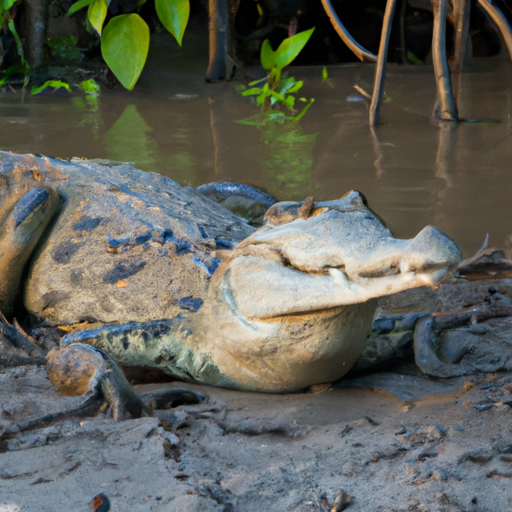
You may think you know the answer, but have you ever wondered what color a crocodile actually is?
In this article, we will explore the fascinating world of crocodiles and discover the true color of these intriguing creatures.
From the murky swamps to the sparkling rivers, you’ll be surprised to find out just how their color plays a crucial role in their survival.
So, without further ado, let’s embark on this adventure and uncover what color truly defines a crocodile!
What Color Is A Crocodile

The Mystique of the Crocodile’s Color
When it comes to the color of a crocodile, the answer may not be as clear-cut as you might think. These majestic creatures, with their formidable jaws and scaly bodies, exhibit a fascinating range of hues across different species and habitats. Let’s explore the colorful world of crocodiles together, as we delve into their diverse colorations and the factors that influence them.
Variations Within Species
Within a single species, crocodiles can display a remarkable variation in color. Take the Nile crocodile, for example, one of the most widely recognized species. While some individuals boast a predominantly gray or brownish coloration, others may exhibit a more reddish or olive-toned hue. This variation can be attributed to several factors, including age, sex, and even geographical location.

Age and Color Evolution
As crocodiles grow and mature, their color may undergo significant changes. Young crocodiles, known as hatchlings, often have lighter colorations. They may feature pale or yellowish-brown hues, often sporting dark bands or spots that provide effective camouflage in the vegetation-rich environments they inhabit.
However, as these young crocodiles age, their coloration gradually darkens. The once-light tones may transform into darker shades of brown or even black as adulthood is reached. These darker colors serve as effective camouflage in the murky waters where crocodiles are known to lurk, making them formidable and almost invisible predators.
Sex and Differences in Color
Another intriguing aspect of crocodile coloration is the variation between males and females. In many species, males tend to be larger and more dominant, displaying deeper and darker hues than their female counterparts. These darkened tones are thought to be a sign of an individual’s maturity and dominance within their social hierarchy.
On the other hand, female crocodiles often exhibit lighter and more muted colors. This difference in coloration is believed to aid in camouflage, allowing them to protect themselves and their young while nesting and caring for their offspring.

Environmental Influences
The crocodile’s color is also influenced by the environment in which it lives. Crocodiles that reside in muddy or murky water may develop darker colorations, which help them blend seamlessly with their surroundings and remain undetected by both prey and predators. Meanwhile, crocodiles living in clearer waters may exhibit lighter shades, adapting to the visibility of their environment.
Furthermore, crocodile habitats can vary greatly, from dense rainforests to arid savannahs. Each habitat presents its unique challenges and opportunities for camouflage, resulting in divergent colorations among different populations. These adaptations to the environment play a crucial role in the survival and success of crocodile species.
A Kaleidoscope of Colors
While it is tempting to imagine crocodiles solely in shades of green and brown, the reality is far more diverse and captivating. Papua New Guinea is home to the stunning Schneider’s smooth-fronted caiman, with its vibrant orange skin and contrasting black markings. The Siamese crocodile of Southeast Asia exhibits a beautiful juxtaposition of dark scales punctuated by pale yellow patches.
Australia’s estuarine crocodile, often known as the “salty,” boasts a mottled grayish-brown coloration, blending seamlessly with its mangrove habitats. In contrast, the American crocodile, with its pale greenish-gray skin, can be found in the mangroves of Florida and the Caribbean.
From the stark black colors of the African slender-snouted crocodile to the striking yellow markings of the spectacled caiman, the color palette of crocodiles spans a vast array of shades and patterns that capture the imagination and ignite curiosity.

The Adaptive Advantage
While the colors of crocodiles may appear mesmerizing to us, they serve a critical purpose in the natural world. These colorations have been refined and honed by evolution to provide these ancient reptiles with a competitive edge in their respective environments.
The ability to blend seamlessly into their surroundings enables crocodiles to become stealthy hunters, ambushing their unsuspecting prey. Conversely, the lighter colors of female crocodiles allow them to remain hidden while protecting their nests and young.
The remarkable kaleidoscope of colors displayed by crocodile species serves as a testament to the incredible diversity and adaptability of these creatures, allowing them to thrive in ecosystems around the globe.
Final Thoughts
So, what color is a crocodile? The answer lies in the intricate interplay between genetics, age, sex, and environmental factors.
Crocodiles are not confined to a singular shade or pattern but span a vast spectrum of colors, each uniquely suited to their respective habitats and roles within their species.
As you delve deeper into the world of crocodiles, you’ll discover a captivating range of colorations that both astound and intrigue.
These incredible reptiles have evolved to become masters of disguise, blending effortlessly into their surroundings and embodying nature’s artistry in every hue and pattern they display.



